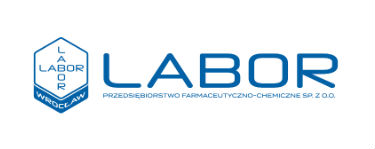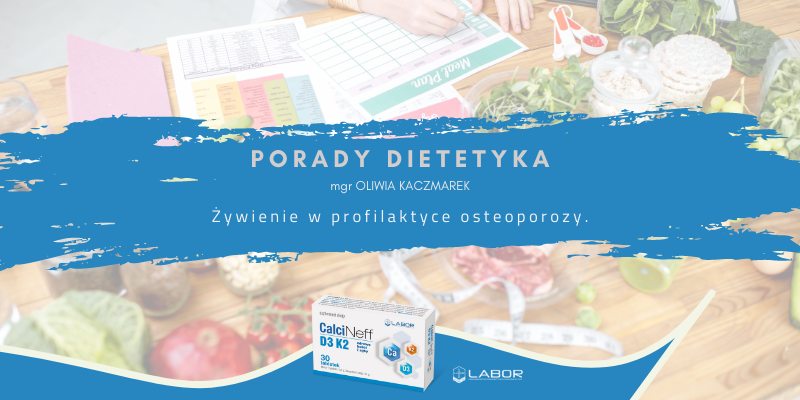Osteoporosis is a disease of the skeletal system characterized by disturbances in the structure of the bone tissue and a decrease in its mass, resulting in an increased risk of fractures and sprains. This disease affects approximately 10% of the world’s population, and the elderly are the most vulnerable to this disease (especially women). The rate of disease development depends on the size of the peak bone mass reached around the age of 25, therefore the prevention of osteoporosis should be taken care of from an early age.
Proper nutrition is of utmost importance in the prevention and treatment of osteoporosis. The diet should provide the body with all the nutrients that affect the structure and mineral condition of bones and maintain the bone mass at an optimal level. Important nutritional factors in the prevention of osteoporosis are: adequate intake of calcium, vitamins and minerals (vitamin C, D, calcium, phosphorus, magnesium) and prebiotics, e.g. fructo-oligosaccharides, found in vegetables, fruits and cereals, such as: garlic, onion, leek , chicory, artichokes, bananas, tomatoes, beet leaves, wheat, barley and rye. Prebiotics stimulate the development of the intestinal microbiota, improving the absorption of nutrients from the consumed foods.
Minerals and vitamins especially important in the prevention of osteoporosis
Calcium
Calcium has several essential functions. Located in the bone tissues, it constitutes the support structure of the skeleton and ensures the hardness of the teeth. In addition, calcium ions are involved in the permeability of cell membranes, conduction of nerve tissue and affect the activity of the heart muscle. According to the standards in force for the Polish population, the recommended daily intake of calcium for adult women and men is 1000?1200 mg during the day. Unfortunately, the average Polish diet is low in calcium. The best sources of it are dairy products and milk containing lactose, which supports the absorption of this element. For people intolerant to lactose or on a vegan diet, it is recommended to include plant products in the diet: broccoli, Brussels sprouts, cabbage, parsley, sesame, poppy seeds, nuts, as well as highly mineralized waters, which can also be considered a valuable source of calcium. It is worth including calcium fortified products in the diet, e.g. milk drinks, breakfast cereals, juices, flour or instead of ordinary natural yoghurt, choose natural yoghurt additionally enriched with this ingredient, which will allow to increase its supply along with the diet.
The absorption of calcium from the digestive tract may be impeded by: digestive system disorders (Crohn’s disease), decreased acidity of the stomach, disturbance of the balance between calcium and phosphorus, excessive consumption of iron, magnesium, zinc, phytates (cereals), oxalates (sorrel, spinach) , excess dietary fat, fiber, alcohol, refined sugar, and caffeine.
Sources of calcium (Ca) in food products:
? a glass of full-fat milk – 295 mg Ca
? small natural yoghurt (200 g) – 340 mg Ca
? a small bottle of natural kefir (300 g) – 309 mg Ca
? 1/4 disc of camembert cheese – 116 mg Ca
? a slice of Gouda cheese (25 g) – 202 mg Ca
? 1/2 medium broccoli – 120 mg Ca
? 1 chicken egg – 26 mg Ca
? a handful of almonds – 72 mg Ca
? 1 cup of cooked beans – 124 mg Ca
? 1/2 a cube of tofu (enriched with Ca) – 315 mg Ca
? chicken breast – 10 mg Ca
? a bag of buckwheat – 25 mg Ca
Phosphorus
In the human body, phosphorus, along with calcium, is the basic component of bone tissue. However, research shows that high phosphorus consumption can cause increased bone loss. As phosphorus is found in large amounts in food, deficiencies are practically non-existent. However, more important is the ratio of calcium to phosphorus, which should be in a 1: 1 ratio.
Foods rich in phosphorus include eggs, meat, offal, fish, dairy products, nuts and cereals. Phosphorus is also added to processed meats, canned food, food concentrates, powdered soups, ready-made frozen meals, sparkling drinks and fast food products.
Magnesium
In the human body, more than half of magnesium is found in bone tissue, about 40% in muscles and 1% in body fluids. Its main function is to ensure proper bone mineralization.
The daily requirement of magnesium for adults ranges from 310?420 mg / day. The most important sources of magnesium are cereal products (millet, buckwheat and brown rice), nuts, legume seeds, dark green vegetables, bananas, dried fruit, almonds, tofu, cocoa. Magnesium absorbability is improved, among others, by vitamin B6, which is why dietary supplements such as MagNeff B6 are a great solution, which provide both of these ingredients.
Vitamin D
The action of vitamin D is important for the absorption of calcium and phosphorus in the gastrointestinal tract and determines the function of osteoblasts (osteogenic cells).
The requirement for vitamin D for women and men aged 19 to 75 years is 15 ?g / day. However, for people over 65 years of age, whose ability to synthesize vitamin D in the skin is limited, it is recommended to supplement this vitamin at a dose of 20 ?g daily.
The human body obtains vitamin D from two sources from skin synthesis and consumed food. Vitamin D products include sea fish (mackerel, salmon, herring), eggs, butter or margarine enriched with vitamin D, mushrooms.
Vitamin D absorption is improved by the presence of vitamins A and C, calcium and phosphorus, essential fatty acids, and exposure to sunlight in the diet, among others. When supplementing the diet with essential nutrients such as calcium or vitamin D, you can use the CalciNeff D3 K2 dietary supplement, which contains high levels of calcium and vitamin D3 in a tablet.
Vitamin C
Vitamin C is a strong antioxidant, necessary in cell regeneration and collagen synthesis. Adequate amounts of it, supplied with the diet (75-90 mg / day), increase the absorption of calcium, magnesium and iron. Fresh and frozen vegetables and fruits such as parsley, peppers, cabbage, kiwi, berries and citrus are good sources of this vitamin.
What to avoid to reduce the risk of osteoporosis?
Excessive consumption of sodium may result in the increased excretion of calcium and magnesium from the body, which reduces bone mineralization and strength. The amount of sodium consumed during the day in the form of adding salt to meals and in ready-made products should not exceed 5 g in total (1 flat teaspoon).
Products rich in sodium include: table salt, smoked fish, cold meats (salami, kabanos, long-ripening meats), yellow cheese, blue cheese, smoked cheese and feta cheese. Due to the frequent presence of salt in food products, it is worth comparing labels in the store and choosing products with a lower salt content.
Factors that adversely affect the skeletal system also include excessive alcohol consumption and smoking. Alcohol increases the excretion of calcium in the urine and may be toxic to osteoblasts. In addition, excessive amounts of alcohol negatively affect the functioning of the liver, which reduces the concentration of active vitamin D. On the other hand, smoking disturbs the bone mineral balance, reduces the production of sex hormones, and inhibits the activity of osteoblasts.
An extremely important aspect in the prevention of osteoporosis is physical activity, which protects the bone tissue, increases muscle mass, improves circulation and allows you to maintain motor coordination. According to the World Health Organization (WHO), 150 minutes of moderate or 75 minutes of vigorous physical activity is recommended per week. Exercises that have a good effect on the bone tissue and do not overload the joints include, for example: walking, light gymnastics, Nordic walking, swimming or cycling.
Sample DAILY FOOD 1900 kcal adapted for elderly people in the prevention of osteoporosis.
BREAKFAST
Vegetable omelette (526 kcal)
Chicken eggs – 2 pieces
Onions – 30 g
Tomato – ? pieces
Paprica – 50 g
Zucchini – 100 g
Yellow cheese – 1 slice
Mushrooms – 5 pieces
Rapeseed oil – 5 g
Graham bread – 2 slices
II BREAKFAST
Green cocktail (255 kcal)
Buttermilk – ? glasses
Kale – 2 handfuls
Banana – ? pieces
Avocados – ? pieces
Almonds – 1 teaspoon (5g)
LUNCH
Vegetable soup + grilled chicken breast (557 kcal)
Potato – 50 g
Italian – 50 g
Green beans – 40 g
Cream 12% – 10 g
Dill – 5 g
+
Chicken breast – 120 g
Rapeseed oil – 5 g
Brown rice – 60 g
Pickled cucumber – 150 g
TEA
Fruit with yogurt (196 kcal)
Natural yogurt with calcium – 150 g
Grated apple – ? pieces
Dried cranberries – 10 g
American blueberry – 20 g
Linseed – 5 g
Cinnamon – a pinch
DINNER
Cottage cheese salad (363 kcal)
Beetroot – ? pieces
Shallot onions – 30 g
Arugula – 1 handful
Green peas – 1 tbsp
Radish – 3 pieces
Avocado – 20 g
Parsley – 5 g
Half-fat cottage cheese – 40 g
Wholemeal bread – 2 slices
Sauce:
Olive oil – 5 g
Wine vinegar – 5 g
Bee honey – 5 g
Bibliography:
– Ciborowska H., Rudnicka A., DIETETICS NUTRITION OF A HEALTHY AND SICK PERSON, 4th Edition PZWL Medical Publishing House, 2019 Warsaw
– Jarosz M. et al., Nutrition standards for the Polish population, National Institute of Public Health – National Institute of Hygiene, 2020
AUTHOR: Oliwia Kaczmarek, MA




